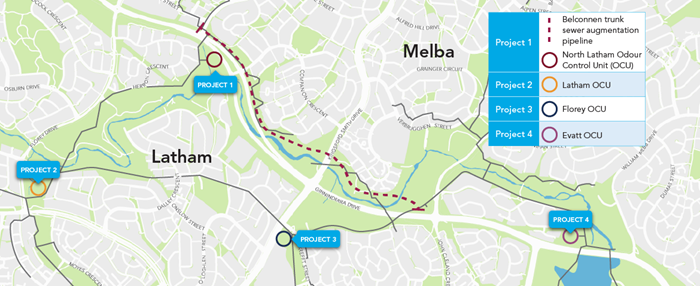Belconnen Trunk Sewer upgrade projects
Construction of the Belconnen trunk sewer was completed in early 2024. The new sewer, which was built in public lands parallel to Ginninderra Drive between Copland Drive, Melba and Tillyard Drive, Charnwood will ensure the reliability of the wastewater network is maintained and meets the needs of the growing population of the Belconnen, Gungahlin and Hall communities.
Please see below for key project information and FAQs.
Community updates
- April 2024 - community update
- August 2023 - community update
- March 2023 - community update
- December 2022 - community update
- November 2022 OCU community update
- July 2022 OCU community update
- April 2022 OCU community update
- March 2022 OCU community update
- March 2022 community update
- December 2021 community update
- November 2021 community update
- October 2021 community update
- Delany Playground October 2021 community update
- August 2021 community update
- June 2021 Companion Crescent Road Closure
- June 2021 Delany Court, Melba. Playground removal
- June 2019 community update
- March 2019 community update
- January 2019 community update
- November 2018 community update
Project overview
The original Belconnen trunk sewer was built in the 1960s and is a critical part of the Belconnen wastewater network which serves Belconnen, Gungahlin and Hall.
Belconnen trunk sewer upgrade project overview
Belconnen trunk sewer pipeline bridge timelapse
Belconnen trunk sewer Evatt OCU mural timelapse
The project consisted of:
- installing approximately ~2.4km of sewer pipe
- installing 18 sewer manholes and four odour control units
- installing a 170m long pipe bridge to cross Ginninderra Creek
- installing four Odour Control Units (OCUs)
- restoring all impacted areas including the replanting of predominantly native species
The new wastewater pipe has been installed within public lands parallel to Ginninderra Drive between Copland Drive Melba and Tillyard Drive, Charnwood. Please refer to the map below for the pipeline location overview.
In addition to improving capacity, the network also requires extra ventilation and OCUs to protect new and existing sewerage infrastructure and minimise impacts to the surrounding community. See our factsheet on the project need.
Progress to date
The complex project included a number of elements that were completed mainly in 2023.
Activity | Status | Completion date |
Sewer pipeline installation | Completed | February 2023 |
170-metre Pipe bridge across Ginninderra Creek | Completed | February 2023 |
Installation of 18 sewer manholes | Completed | November 2022 |
Restoration of pipeline corridor and site compound | Completed | October 2023 |
North Latham OCU | Completed | October 2023 |
Latham OCU | Completed | November 2023 |
Florey OCU | Completed | October 2023 |
Evatt OCU | Completed | September 2023 |
Mural artworks for OCU buildings | Completed | December 2023 |
Restoration of OCU sites | Completed. As part of our landscaping plans, areas of high environmental sensitivity including Natural Temperate Grasslands (NTG), are being restored and protected. These NTG areas will continue to be monitored and maintained until early 2026. | February 2024 |
Like most of Australia’s capital cities, Canberra’s population is growing and this increases demand on our water and sewer infrastructure. Major development has recently occurred in the Gungahlin region, and planned development at the University of Canberra, the suburb of Lawson, CSIRO's Ginninderra Field Station and an increase in infill development generally, mean that the sewer is nearing capacity and needs to be upgraded to ensure it can continue to meet demand.
During extreme wet weather events, rainwater and an already steady flow in the wastewater network can result in sewage escaping from the sewer pipes into Ginninderra Creek. Icon Water appreciates how valued the environment and waterways are and these projects will ensure that any risk of overflow into local waterways is significantly reduced.
In addition to the new sewer pipe being installed, the projects will also include four OCUs which will be constructed within public lands in Latham, Florey, Evatt and North Latham.
Odour Control Units (OCUs)
Odour Control Units - OCUs are a vital part of the sewer network as they protect the sewer pipes from corrosion and reduce odour through filtration and ventilation. Ventilation using an OCU extends the life of a sewer by reducing the amount of maintenance that the pipeline needs allowing more efficient management of the existing network.
The filters used in the OCU and ventilation stacks absorb gases such as hydrogen sulphide, which is a common source of odour from sewerage systems.

